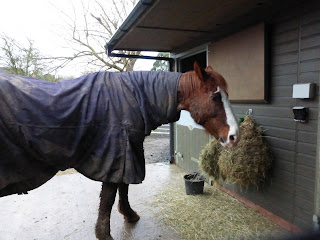What is it?
Azoturia is sometimes called Monday morning disease because in the past it often showed up in working horses, for example, draught horses or pit ponies on a Monday after they had been rested over the weekend but still fed lots of grain. However, the official name is Equine Exertional Rhabdomyolysis. It is, basically, severe muscle cramps and is usually seen in the hindquarters and back. Tying up is a less severe form of Azoturia.
Signs
These can vary depending on severity but often include:
- reluctance to move
- shorter steps - therefore appearing stiff
- stiffness
- pain
- sweating
- laboured breathing - if the pain is severe
- muscle tremor
- stiffness may become so bad that the horse can't move and/or may lie down
- the affected muscles are hard to the touch and painful - cramp
- dehydration
- urine may be dark
- some signs may be similar to colic eg: pawing the ground, looking at the flanks
The causes are not totally understood but horses that are worked irregularly but still fed a diet which is high in grain are generally the most susceptible. The grain (carbohydrate) is converted to glycogen which is the fuel muscles use for energy. Excess glycogen is stored in the muscles (and elsewhere) so if a horse is rested for a few days and still fed plenty of grain the excess glycogen (unused due to no exercise) will be stored in the muscles. Then when the horse begins work again this glycogen is used. Usually glycogen is metabolised (broken down) by using oxygen in the blood. If the blood can't carry enough oxygen quickly enough glycogen is metabolised without oxygen, however, this produces waste products. If there is a lot of stored glycogen it can't all be metabolised using oxygen and there are a lot of waste products produced which cause damage to the muscle fibres!
Diagnosis
A vet can confirm Azoturia from a horse's history and taking a blood test to look at enzyme levels. Urine samples can be tested as these will show waste products from the breakdown of muscle tissue.
Treatment
Stop exercising immediately if you notice the horse is tying up. Call the vet. If you are close, gently take the horse back to the stable, if out on a hack the horse will need to be transported home in a box or trailer. Keep the horse warm - rugged if necessary and still.
Following blood results the vet may give a muscle relaxant, diuretics, tranquilisers and/or anti-inflammatory drugs. Specially prepared fluids may also be given my stomach tube or intravenously. The horse should not be fed any grain and should be box rested for a few days. Heat therapy, massage or in hand walking may be suggested by the vet.
Re-introduction of work should be done on the vet's advice and will be gentle and slow.
Prevention
Particularly look at your horse's diet. As I have mentioned in my feeding blogs in the past, a horse should be fed primarily roughage ie: grass, hay or haylage. If there is a requirement for more energy or nutrients then use a roughage based feed eg: alfalfa and avoid feeding grains. Cubes or mix if fed should be chosen based on a low starch content and sugarbeet is also a good fibre source.
Ensure your horse is receiving all the nutrients he needs (see my blogs) as any imbalance can affect the electrolyte balance. This will need re-evaluating as the horse becomes older as nutrients are not absorbed as effectively in the older horse.
This is also another reason why when getting a horse fit you should increase workload BEFORE increasing the feed!
I have seen horses and ponies who suffer from this over the years. Understanding feeding and fitness can help you reduce the chances of your horse suffering.
Have you seen this week's vlog 'January Update' on my You Tube channel?
Horse Life and Love. Please check it out and SUBSCRIBE.
You can also follow me on Facebook and Instagram for updates on Chesney, Basil, Tommy and Daisy.
Until next time!
Jo



















